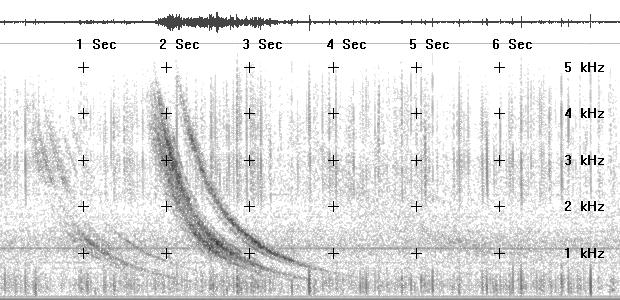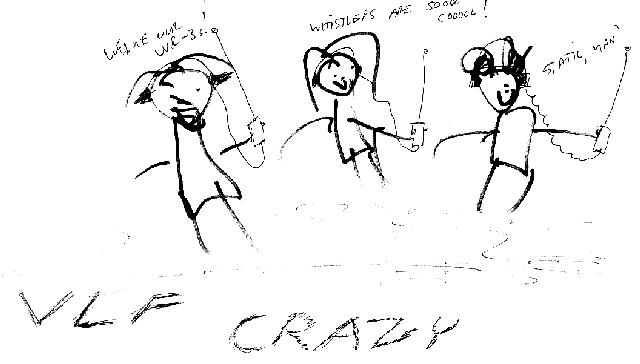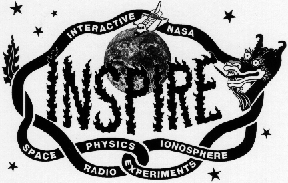
A spectrogram of a whistler recorded in northern Nevada, 19 Sept. 1996 - 2358 UT - McGreevy
The term "VLF" (very-low-frequency) is used rather loosely when referring to Natural Radio, since naturally-occurring radio signals actually are heard at ELF through VLF radio frequencies, especially between 300 Hz (or cycles-per-second) up through 6 or 7 kHz.
"VLF" is usually thought of as the 3 kHz (3000 Hz) through 30 kHz radio-frequency range. "ELF" is 300 Hz to 3000 Hz, "ULF" is below 300 Hz radio-freqs., (though opinion differs when it comes to the terms ULF and ELF - most agree that ULF refers to below 300 Hz toward below 1 Hz - really LOW frequencies!)
It is at the AUDIO-frequencies (not sound but radio signals) are where a wondrous variety of "Natural Radio" sounds, like chorus, whistlers, and the strange and spooky "wavering tones" can be heard.

During the war, amplifiers were used by both sides on the front to overhear telephone communications from the enemy. As a result of poor insulation, there were induction effects that caused stray earth-currents far from the vicinity of the telephone cables. High amplification was able to make these extremely weak signals hearable. The monitoring grounds were usually 100 metres apart, and simply guided the signals to the amplifier and earphone.
Sometimes a peculiar whistling tone was heard. On the front when they heard the tones the men said, "The bombs are flying!"
The characteristics of the tones was something that sounded like "PIOU". My observations are that the tones are amplitude-stable, but very rapidly they change frequency, beginning with the highest tone and decaying to the lowest hearable tone. The tones seem especially pronounced at about 1000 cycles (per-second, or 1 kHz). The entire phenomenon lasts a full second. On some days these whistles were so loud and frequent that it was useless to monitor for telephone communications. This phenomenon certainly depends on some meteorological influence. Crackles and burbles were especially prevalent during normal atmospheric disturbances on mornings in May and June.
The 'earth electrodes' sometimes also picked up noise, but this can hardly be the cause of the whistles.
I have myself in the laboratory futile troubles to make a connection with direct discharges and such whistles.
Where for certain in the Earth and in the sea these distinct weak-signals originate is unexplainable. Perhaps with this apparatus, wider intelligence can be brought to bear to clarify and contribute.
Dresden, Institute for Weak Current Technology, entered 17 May 1919, by: H. Barkhausen; from Physik.Zeitschr.
Rather than delve here into further explanations of Earth's beautiful and intriguing Natural Radio sounds--which I have become utterly "hooked" with and now make these efforts to introduce it to the world--I have written an article entitled VLF STORY for your enjoyment and information.
This essay into my Natural Radio listening experiences and information about Natural Radio. THE VLF STORY appeared in January 1995 in a book called The Whistler Serenade by Donald Cyr and James Brett and currently is also appearing in a few other Web and printed publications in various modified versions.
We're well into Solar-Cycle 23 and are witnessing rapidly-increasing solar activity (flares, coronal mass ejections). These will
create more disturbances to Earth's magnetic field and will consequently spawn much more interesting events to
monitor at mid-latitudes, such as more whistler events, more dawn chorus and other various
emissions. Omega Radionavigation System shut down in September 1997, leaving the VLF band now free from
its high-pitched beeping sounds. We're now into what I feel is the coming "Golden Period" (the years during and just after solar maximum - 2000 - 2004)
with ELF/VLF monitoring and listening will really be good!

McGreevy ground-based Monorual and now STEREO Natural VLF Radio recordings .WAV files (Windows 3.1x and Win95/98 format) can be downloaded and listened to courtesy a Web server at the University of Iowa Plasma Wave Group. Many of these are on the CD and with far better quality than the lower sampling rate of the .WAV files (most of which are 11.025 kHz/8-bit to save disk space and downloading time). These recordings were made from 1993 - 1996 and just recently in June 1998, I embarked upon a STEREO natural radio recording expedition to Waterton Peace Park in the southern Alberta Rocky Mountains of Canada.
From this U. of Iowa site, you can also download GRAM4.2, a Windows 3.1 freeware spectrogram program written by R. S. Horne. GRAM23 works with sound cards to analyze the frequency-versus-time aspects of Natural Radio and other sounds. Please see next link below for updated version of this fantastic spectrogram program.
NEW: PROJECT INSPIRE STS-45 DATA REPORT, by Michael Mideke, Project Data Analyist. (at this address: http://www.qnet.com/~vlfradio/in_top.html) This report covers the Shuttle STS-45 flight FO7 operations and the Back-up Recording sessions over the period of 26 - 31 March 1992. This was INSPIRE's first large-scale project employing hundreds of ground-based receiving stations operated by student groups and individuals, including myself. I have just completed scanning in the text-portion of this report (massive!). Text-only.
Updated freeware spectrogram program capable of analyzing stereo sound-files by R.S. Horne, including program and contact information
(Gram version 4.2.5 for Win 95/NT)
Dave in north-eastern Holland has a fantastic web site showing photos of his finished receiver and antenna to BNC jack adaptations for use with his own constructed McGreevy BBB-4 receiver. The URL of his web site with this information is: http://www.rcg.nl/~dave/elfspecial.html. And if tne audio frequencies of natural radio are not low enough, Dave studies ULF radio frequencies where the mysterious earthquake signals lie. WWW.ELFRAD.NET.
Longwave Radio Club of America Home Page: http://www.lwca.org
. Discover more about the amazing world of radio below 500 kHz.
Articles appearing in the LWCA's LOWDOWN (monthly printed bulletin)
were the original inspiration to start my own journey down the
Natural Radio research and recording path back in 1988. Hats off
to John Davis, web-master.
Related to Project INSPIRE, Brad Olsen and a team mate (both are high-school
students) have created a beautiful and graphic-rich Web page on
VLF radio at: http://tqd.advanced.org/2784/.
These fellows are hoping to win a University scholarship, and
judging by their fabulous work evident on ther Natural radio web
pages, is seems they will succeed.
Society of Amateur Scientists Home Page
Fascinating, Fun projects to read about and tinker with. Many
of these projects are not simple basic projects but ones requiring
some technical knowledge. Others are great to work on with children,
understandable as they are to young, growing minds. Hats-off to
Bill Beaty for his Web work there.
Worldwide Utilities News (WUN).
The first dedicated electronic utility club in the world and their
fascinating mothly electronic newsletter. THE VLF STORY has appeared
here between July - September 1996..
Build your own VLF receiver(s) info page at:
Homebrew Receivers for ELF-VLF Natural Radio

NASA INSPIRE PROGRAM
NASA INSPIRE PROGRAM:
Fascinating Natural Radio monitoring program for High-School and
College students as well as ANYONE with a desire to participate
in real-time scientific VLF radio studies!

Bill (Altair) Payne's VLF-ULF web site is chock-full of related information,
including some audio file examples of natural radio and other radio-science information (Jupiter HF signals, ULF signals below 10 Hz, etc.) plus LOTS of great links to other sites, including back to this one.
Stephen P. McGreevy,
P.O. Box 928, Lone Pine, CA 93545-0928 USA
Updated by Stephen P. McGreevy, 05 Nov. 2000
